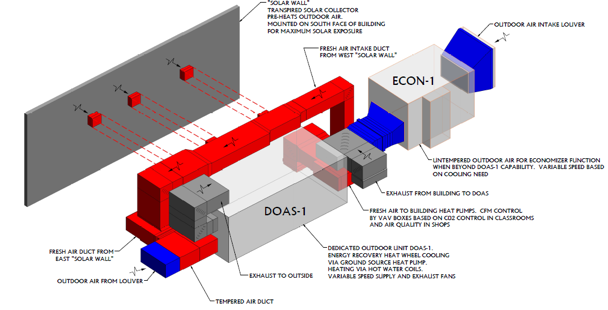DOAS Improves Ventilation and Indoor Air Quality for Montana Buildings
A dedicated outdoor air system (DOAS) uses separate equipment to condition all of the outdoor air brought into a building for ventilation. Then, either directly or in conjunction with local or central HVAC units, DOAS delivers the air to each occupied space. Space temperatures are maintained by the local or central HVAC units. This approach not only improves ventilation and humidity control and significantly reduces energy use, it also enhances indoor environmental quality by delivering 100% fresh air throughout the building.
DOAS can be implemented effectively in almost any type of commercial, institutional, industrial or multifamily building. While this system is beneficial to any building type, buildings with strict indoor air quality, ventilation, humidity, or energy efficiency requirements can benefit the most. Also, as the ratio of outdoor air to recirculated air increases, DOAS benefits increase accordingly.
DOAS achieves energy savings by optimizing use of ventilation air, precooling/heating the outdoor air using energy recovery, and allowing the interior loads to be handled at higher refrigeration temperatures and COP.2 Depending on configuration and location, DOAS achieves energy savings in the range of 8–12% for space heating and 15–20% for space cooling.
DOAS AT-A-GLANCE
- BUILDING SET-UP: Ideal for buildings with strict ventilation requirements
- BUILDING TYPE: Schools, offices, hospitals, hotels, restaurants, retail, apartments
- BUILDING SIZE: Small-, mid- and large-sized buildings
- CODE READINESS: Code ready
CASE STUDY: Norm Asbjornson Hall, Montana State University
Using incentives from NorthWestern Energy’s E+ Business Partners program, Montana State University integrated DOAS with transpired solar collectors and economizers in their newest building—Norm Asbjornson Hall. Building inhabitants now enjoy fresh air provided by a DOAS system with a heat wheel and a fresh-air-tempering geothermal heat pump.
To learn about NorthWestern’s commercial efficiency programs, visit northwesternenergy.com/eplus.

A STEP FURTHER: Very High Efficiency DOAS (VHE DOAS)
VHE DOAS improves the overall efficiency of the DOAS concept by pairing a high-performance heating and cooling system, such as a heat pump or variable refrigerant flow (VRF), with a very high efficiency heat recovery ventilator (HRV) or energy recovery ventilator (ERV), and optimized system design. Preliminary analysis of eight pilot projects conducted in the Pacific Northwest shows an average of 41% whole building energy savings and 63% HVAC savings over code minimum replacement of the existing equipment.
